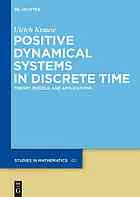Table Of ContentUlrichKrause
PositiveDynamicalSystemsinDiscreteTime
De Gruyter Studies in
Mathematics
|
Editedby
CarstenCarstensen,Berlin,Germany
NicolaFusco,Napoli,Italy
FritzGesztesy,Columbia,Missouri,USA
NielsJacob,Swansea,UnitedKingdom
Karl-HermannNeeb,Erlangen,Germany
Volume 62
Ulrich Krause
Positive Dynamical
Systems in Discrete
Time
|
Theory, Models, and Applications
MathematicsSubjectClassification2010
15B48,37B55,39B12,47B65,47H07,47N10,60J10
Author
Prof.Dr.Dr.UlrichKrause
UniversitätBremen
Fachbereich03–Mathematik/Informatik
Bibliothekstr.1
28359Bremen
Germany
krause@math.uni-bremen.de
ISBN978-3-11-036975-5
e-ISBN(PDF)978-3-11-036569-6
e-ISBN(EPUB)978-3-11-039134-3
Set-ISBN978-3-11-036571-9
ISSN0179-0986
LibraryofCongressCataloging-in-PublicationData
ACIPcatalogrecordforthisbookhasbeenappliedforattheLibraryofCongress.
BibliographicinformationpublishedbytheDeutscheNationalbibliothek
TheDeutscheNationalbibliothekliststhispublicationintheDeutscheNationalbibliografie;
detailedbibliographicdataareavailableontheInternetathttp://dnb.dnb.de.
©2015WalterdeGruyterGmbH,Berlin/Munich/Boston
Typesetting:PTP-Berlin,ProtagoTEX-ProductionGmbH
Printingandbinding:CPIbooksGmbH,Leck
♾Printedonacid-freepaper
PrintedinGermany
www.degruyter.com
|
ToCarolaandDaniel
Preface
Positivedynamicalsystemscomeintoplaywhenrelevantvariablesofasystemtakeon
valueswhicharenonnegativeinanaturalway.Thisisthecase,forexample,infields
asbiology,demographyandeconomics,wherethelevelsofpopulationsorpricesof
goodsarepositive.Positivitycomesinalsoiftheformationofaveragesbyweighted
meansisrelevantsinceweights,forexampleprobabilities,arenotnegative.Thisis
thecaseinquitediversefieldsrangingfromelectricalengineeringoverphysicsand
computersciencetosociology.Therebyaveragingtakesplacewithrespecttosignals
in a sensor network or in a swarm (of birds or robots) or with respect to velocities
ofparticlesortheopinionsofpeople.Inthefieldsmentionedthedynamicsisoften
modeledbydifferenceequationswhichmeansthattimeistreatedasdiscrete.Thus,
inrealityonemeetsahugevarietyofpositivedynamicalsystemsindiscretetime.
Inmanycasesthesesystemscanbecapturedbyalinearmappinggivenbyanon-
negativematrix.Thedynamics(indiscretetime)thenisgivenbythepowersofthe
matrixor,equivalently,bytheiteratesofthelinearmappingwhichmapsthepositive
orthantintoitself.ApowerfultoolthenisthePerron–FrobeniusTheoryofnonnega-
tivematrices(includingtheasymptoticbehaviorofpowersofthosematrices)which
hasbeensuccessfulsinceitsinceptionbyO.PerronandG.Frobeniusoverabouthun-
dredyearsago.Concerningtheoryaswellasapplicationstherearetwoinsufficient
aspectsofPerron–FrobeniusTheorywhichlaterondrovethistheoryintonewdirec-
tions.Thefirstaspectisthatthistheoryisnotjustaboutnonnegativematricesbut
applies happily also to certain matrices with negative entries. This means that the
theory should be understood as dealing with linear selfmappings of convex cones
infinitedimensionsnotjustofthestandardcone,thepositiveorthant.Thesecond
aspectis thatevensimple positive dynamicalsystems are not linear.Thus,whatis
neededisanextensionofclassicalPerron–FrobeniusTheorytononlinearselfmap-
pingsofconvexconesinfinitedimensions.Moreover,withrespecttotheoryaswell
asapplications,suchanextensionisneededalsoininfinitedimensions.Sinceclassi-
calPerron–FrobeniusTheoryhasalreadysomanyapplicationsonecanimaginethe
greatvarietyofapplicationssuchanextensiontononlinearselfmappingsininfinite
dimensionswillhave.
It is the aim of the present book to provide a systematic, rigorous and self–
contained treatment of positive dynamical systems based on the analysis of the it-
erations of nonlinear selfmappings of a convex cone in some real vector space. To
pursuethistask,helpcomesfromabeautifulapproachdevelopedforthelinearcase
byG.BirkhoffconsideringJentzsch’sTheoremininfinitedimensionsand,indepen-
dently, by H. Samelson considering Perron–Frobenius Theory in finite dimensions.
Thecrucialpointofthisapproachisthetranslationofastrongpositivitypropertyof
Preface | vii
thelinearmappingintoacontractivitypropertywithrespecttosomemetricinternal
totheconvex cone.Thismetrichasbeenused longbefore byD.Hilbertwithinthe
completelydifferentareaofthefoundationsofgeometryandiscalledHilbert’spro-
jectivemetric(aquasi–metric,actually).Theextensionofthisapproach,alsocalled
theBirkhoffprogram,tononlinearselfmappingsofconvexconesisacornerstoneof
thepresentbook.Asitturnsouttheinvestigationofthenonlinearityismadeeasier
byhavingitbasedonaconvexconeanditsanalysis.Sincetheconvexconereflects
thepositivityofthesystemonemightsaythatpositivityhelpstotamenonlinearity.
Manybeautifulresultsareavailablewhichareimpossiblewithoutpositivity.
Thefollowingparagraphssketchbrieflythecontentofeachoftheeightchapters
ofthebook.
Chapter1motivatesthestudyofpositivedynamicalsystems(indiscretetime)by
means of examples from biology and economics. As for biology a nonlinear exten-
sionof theclassicalLeslie modelusedinpopulationdynamicsanddemographyis
presented by taking population pressure into account. Considering economics, for
thelikewiseclassicalLeontiefmodelofcommodityproductionanonlinearextension
istreatedwhichcapturesthechoiceoftechniques.Therearemuchmoreexamples
of nonlinear positive dynamical systems. The example of opinion dynamics under
boundedconfidencehasrecentlyattractedmuchattentionandwillbeinvestigated
inthelastchapterofthebook.
Chapter2on“ConcavePerron–FrobeniusTheory”presentsanextensionofclassi-
calPerron–FrobeniusTheoryfromlineartoconcavemappings(includinglinearones).
IntheproofsHilbert’sprojectivemetricmakesitsfirstappearance.Thepointtherebyis
thatforthismetricconcavemappingsarecontractionsandtheinteriorofthestandard
coneiscomplete.BythisPerron–FrobeniustheoremscanbeprovedusingBanach’s
contraction mapping principle. Though only a particular form of nonlinearity con-
cavitycoversthenonlinearitiesinthemodelsofLeslieandLeontief.Whereasinlater
chaptersmoregeneralnonlinearitieswillbetackledon,thischapterconcentratesjust
on concave mappings since for these a variety of results is possible comparable to
thoseofclassicalPerron–FrobeniusTheory.Itshouldbenoted,however,thateven
concaveselfmappingsofthestandardconeinfinitedimensionsexhibitalreadyspec-
tralpropertiesinsharpcontrasttothelinearcaseinthattheremaybeinfinitelymany
eigenvalues.
Whereasinthefirsttwochapterspositivityisrestrictedtothestandardconein
finitedimensions,theoryaswellasapplicationsinlaterchaptersrequiremoregeneral
convexconesininfinitedimensions.
Chapter3on“Internalmetricsonconvexcones”treatsgeneralconvexconesin
topologicalvectorspaceswithafocusoninternalmetrics.Thelatterare(quasi–)met-
ricssolelydeterminedbythecone’sconvexstructure.Hilbert’sprojectivemetricand
theThompsonmetricorpartmetricarethemostrelevantinternalmetricsbutthere
aremuchmore.Besidescertaingeometricalpropertiesofinternalmetricsthechapter
concentratesoncriteriaforaconvexconetobecompleteforaninternalmetric.For
viii | Preface
laterusethetopologyofthevectorspaceisrelatedtotheoneinducedbyaninter-
nalmetricandcriteriaforinternalcompletenessareobtainedintermsofthevector
space topology. A particularcase is the result obtained first by G. Birkhoff that the
positiveconeofaBanachlattice–aswellasitsinterior–arecompleteforHilbert’s
projectivemetric.ExtendingthemethodappliedinChapter2forfinitedimensions,by
Chapter3selfmappingsofaconvexconecanbelookedatasselfmappingsofacom-
pletemetric space. Sincelater on contractivitywith respect to internalmetrics will
playarole,Chapter4on“Contractivedynamicsonmetricspaces”investigatesvar-
ioustypesofcontractivityingeneralmetricspaces.Conditionsarespecifiedwhich
guaranteepointwiseconvergenceoftheiteratesofaselfmappingtoafixedpoint.An
importantprinciplestatesthatthisglobalpropertyappliesalreadyifitholdslocally
incaseofpower–lipschitzianmappings(includingnonexpansivemappings).Forlater
applicationstononautonomouspositivesystemsthecompositionofinfinitelymany
selfmappingsanditsasymptoticbehaviourisanalyzed.
Both,Chapter3andChapter4supplyinageneralsettingtoolsneededinsubse-
quentchapters.Besidethis,bothchapterspresentknownandnewresultswhichare
interestinginitself.
Chapter5on“Ascendingdynamicsinconvexconesofinfinitedimension”presents
afar–reachingextensionofChapter2toconvexconesininfinitedimensionsandcor-
respondingselfmappingsincludingconcaveones.Anascendingoperatoris,roughly
speaking,aselfmappingofaconvexcone,thevaluesofwhich,onasubsetofthecone,
increasewithrespecttothecone’sorderingonvectorsaswellaswithrespecttothe
commonorderonpositivescalars.Itisanimportantfeatureofascendingoperators
tobepositivewithoutbeingnecessarilymonotone.
InthelinearcasetheuniformlypositivelinearoperatorsintroducedbyG.Birkhoff
areexamples.Nonlinearexamplesaretheu –concaveoperatorsstudiedbyM.Kras-
0
noselskiiandhiscollaborators.Whereasthesemappingsneedtobemonotone,this
is,however,notthecaseforascendingoperatorsingeneral.UsingHilbert’sprojective
metricforascendingoperatorsrelativestabilityisproven,meaningtheiteratesofthe
normalizedoperatorsdoconvergetoaneigenvector.Usingthepartmetricforweakly
ascendingoperators,absolutestabilityisshownthatistheiteratesconvergetoafixed
point.Applicationsconcernnonlineardifferenceequationsandanonlinearversion
ofJentzsch’sTheoremonintegraloperators,includinganapproximationalgorithmto
computetheuniquesolution.
Chapter6on“Limitsettrichotomy”investigatesafundamentalphenomenonof
positivedynamicalsystemswhichmeansthateitherallorbitstendtoinfinityorall
orbitstendtozeroorallorbitstendtoafixedpointintheinteriorofthecone.Vari-
ousconditionsforthisphenomenontohappenarespecified.Limitsettrichotomycan
beusedinmanyways,itguarantees,forexample,theexistenceofagloballystable
fixedpointintheinteriorifthereexistsanorbitpositivelyboundedfrombelowand
above.Forthecaseofdifferentiableselfmappingsinfinitedimensionseasytocheck
conditionsforlimitsettrichotomyaregiven.Anapplicationistononlineardifference
Preface | ix
equationsincludingageneralizednonlinearFibonacciequation.Anotherapplication
considerscooperativesystemsofdifferentialequationswithabiochemicalcontrolcir-
cuitasaparticularexample.
Chapter7on“Nonautonomouspositivesystems”dealswiththeasymptoticbehav-
iorofcompositionsofinfinitelymanyselfmappingsofaconvexcone.Variouskinds
ofbehaviouraspathstability,asymptoticproportionality,weakandstrongergodicity
areanalyzed.Theresultonconcaveweakergodicityisanextensionofthefamous(lin-
ear)Coale–LopezTheoremindemography.Anothernonlinearextensionconcernsthe
classicalstrongergodicitytheoremfornonnegativematrices.Furthermore,abeautiful
theoremofH.Poincaréonnonautonomouslineardifferenceequationsisextendedto
includenonlineardifferenceequations.Also,thenonlinearversionsofthemodelsof
LeslieandLeontiefintroducedinthefirstchapterareinvestigatedforsurvivalreates
dependentontimeandfortime–dependenttechnicalchange,respectively.Finally,
forpopulationsbeingunderenforcementfromtheenvironmentconditionsonpopu-
lationpressurearegivenwhichstillyieldpathstability.
Thelastandlongestchapter,Chapter8,isonthe“Dynamicsofinteraction:Opin-
ions,meanmaps,multi–agentcoordination,andswarms”.Itistheaimofthischapter
todevelopasystematicandrigorousanalysisforthedynamicsofseveralfascinating
kindsofinteraction.Suchinteractionshavebeenaddressedrecentlyinawidespread
and fastly growingliteratureby researchers from quitedifferentfields whichrange
fromelectricalengineeringoverphysicsandcomputersciencetosociologyandeco-
nomics.Theleadingquestiontherebyasksunderwhatconditionsagroupofagents,
beingitrobotersorhumansorotherkindsofanimals,isabletocoordinatethemselve
toreachaconsensus.Mathematically,thelattermeansforadynamicalsystemwith
severalcomponentswhethertheseconvergealltothesamestate.Initsmostsimple
caseoneconsidersanonnegativematrixwithallrowssumminguptooneandasks
forconditionsunderwhichthepowersofthematrixconvergetoamatrixhavingall
itsrowsequal.Theanswerinthisspecialcaseisthatthishappenspreciselyifthema-
trixhasapowerwhichisscrambling.Thisis(asharpenedversionof)thewell–known
BasicLimitTheoremforMarkovChains.Alreadysimplecasesofinteraction,however,
arenonlinear(ortime–variant)asforthemodelofopiniondynamicsunderbounded
confidence(alsoknownasHegselmann–Krausemodelintheliterature)whichhasat-
tractedmanyresearchersinrecentyears.Anonlinearanalogueofa(row–)stochastic
matrixisameanmap.Concerningtime–varianceoneconsidersasequenceofstochas-
ticmatrices.Bothcasesleadtopositivedynamicalsystemsasconsideredinprevious
chapters.Facingtheparticulartypeofconvergencetoconsensustoolsadaptedtothat
aredevelopedinChapter8.Incaseoftime–variancethesearetoolstohandleinfinite
productsofstochasticmatrices.Whatisneededareconditionsonthestructureand
intensityofinteractionwhichmaketheinfiniteproductconvergenttoamatrixwith
equalrows.Anoftenusedtool,thetheoremofWolfowitz,isgeneralized.Thechapter
concludeswithanapplicationtothedynamicsofswarmsofbirds.Therecentlymuch
x | Preface
discussedCucker–Smalemodelistreatedandanewmodelofswarmingisdeveloped
wherebirdsareformingswarmsundersomeweakerconditionsoninteraction.
Eachchapterissubdividedintosectionsthematerialofwhichisillustratedbyex-
amplesandcontainsexercisesrangingfromsimpleverificationsoveradditionaltop-
icstoopenproblems.Remarkscommentonresultsobtainedandprovidelinkstothe
literature.Ineachchapterresults,examples,remarksareconsecutivelynumberedby
a.b.cwhereareferstothechapter,btothesectionandctotheparticularitem.Each
chapterappendedisabibliographyspecifictoit.Alistofnotationsandanindexcon-
cludethebook.
The book is directed to researchers from various disciplines and graduate stu-
dents,too,whoareinterestedinpositivedynamicalsystems.
Thebookisself–containedandorganizedinamannersuchthatitsmaterialcan
alsobeusedincoursesandseminars.Chapters1and2requireonlyabasicknowledge
inlinearalgebraandanalysisandcouldbeusedforanintroductorycourseinnonlin-
earPerron–FrobeniusTheoryincludingapplications.Chapters3,4,and5couldserve
asmaterialinacourseorseminarforgraduatestudentsandrequiresomefamiliar-
itywithfundamentalconceptsintopologyandfunctionalanalysis.Thesameapplies
toChapters6and7whichcouldbeusedasmaterialinanadvancedcourse.Thelast
Chapter8canbereadindependentlyofthepreviousonesandcouldserveasanintro-
ductionintorecentapplicationsofpositivedynamicalsystems.Thefascinatingtopics
aresuitableforgraduatestudentstoworkon,analyticallyaswellasbydoingcom-
putersimulations.
ThisbookgrewoutofseveralcoursesandseminarsIheldovertheyearsatthe
UniversityofBremen.Itwasagreatexperiencetosharewiththestudentstheenthu-
siasmforafieldwhichisjustinthebeginning.Iliketothankallthestudentsfortheir
contributionsandIwanttomentioninparticularTimNesemannandJanLorenz.The
readerwillconsultthereferencesgiveninthebooktotheirworkandthatofotherstu-
dentsaswellastotheworkofresearchersIenjoyedtowritejointpaperswith.HereI
liketothankChristianBidard,RainerHegselmann,DiederichHinrichsen,TakaoFu-
jimoto,TimNesemann,RogerNussbaum,MihályPituk,PeterRanft,DietrichWeller.
Furthermore,IwanttothankBirgitFeddersenfromtheDepartmentofMathemat-
icsforherexperiencedandnicetranslationofthemanuscriptintoLaTex,including
thefigures.
FormanycarefulandhelpfulcommentsIhavetothankthethreeanonymousre-
viewersofthemanuscript.
Finally,IwanttothankthepublisherDeGruyterandinparticularFriederikeDitt-
bernerandSilkeHutt,whohavebeenmosthelpfulintheprocessofpublication.
ThebookIdedicatetomywifeCarolaandtooursonDanielwhostayedsofriendly
tosomeonewholivedwithadeskfordays,monthsandyears.
Bremen,November2014 UlrichKrause

